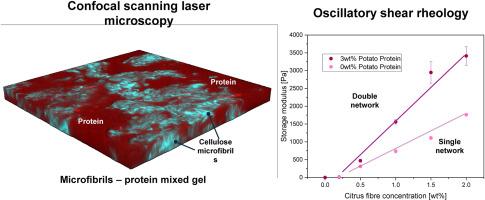利用纤维素微原纤维和马铃薯蛋白形成双网状凝胶
IF 11
1区 农林科学
Q1 CHEMISTRY, APPLIED
引用次数: 0
摘要
利用柑桔纤维微原纤维和热胶化马铃薯蛋白,研究了双网水凝胶体系的形成。我们研究了系统如何从单网络转变为双网络凝胶,因为马铃薯蛋白质网络形成了纤维素微原纤维网络内纠缠的第二个网络。系统通过振荡流变学,即温度和振幅扫描来研究。我们发现原生马铃薯蛋白对单网纤维素微纤维凝胶的贡献是最小的。然而,当蛋白质热变性时,纤维素微原纤维和凝胶蛋白协同作用,有助于双网凝胶的储存模量。在低蛋白质浓度下,纤维素微纤维网络的加入降低了凝胶形成的最低蛋白质浓度。在低至中等蛋白质浓度下,纤维素网络相互渗透蛋白质网络,显著增加弹性模量。在高浓度的蛋白质中,蛋白质凝胶网络完全主导了流变反应,尽管这是在蛋白质与纤维的一定比例下观察到的。我们通过共聚焦激光扫描显微镜将观察到的流变特性与微观结构联系起来。观察到纤维素微原纤维的絮凝体,二级蛋白网络缠绕在整个纤维中。这些密集的絮凝体可能是提高双网体系力学性能的关键因素。本文章由计算机程序翻译,如有差异,请以英文原文为准。

Use of cellulose microfibrils and potato protein to form double network gels
The formation of double network hydrogel systems is investigated using cellulose microfibrils from citrus fibre and a thermally gelling potato protein. We study how the system transitions from a single, to a double network gel, as the potato protein network forms a second network entangled within the network of cellulose microfibrils. The system is studied via oscillatory rheology, namely temperature and amplitude sweeps. We find that the contribution of the native potato protein on the single network cellulose microfibril gel is minimal. However, when the protein is thermally denatured, the cellulose microfibrils and gelled protein act synergistically to contribute to the storage modulus of the double network gel. At low protein concentrations, the addition of the cellulose microfibril network reduces the minimum protein concentration for gel formation. At low to moderate protein concentrations, the cellulose network interpenetrates the protein network, significantly increasing the elastic modulus. At high concentrations of protein, the protein gel network entirely dominates the rheological response, though this is observed up to a certain ratio of protein to fibre. We link the observed rheological properties to the microstructure via confocal laser scanning microscopy. Flocs of the cellulose microfibrils are observed with the secondary protein network entangled throughout. These dense flocs are likely to be the key contributor to the increased mechanical properties of the double network system.
求助全文
通过发布文献求助,成功后即可免费获取论文全文。
去求助
来源期刊

Food Hydrocolloids
工程技术-食品科技
CiteScore
19.90
自引率
14.00%
发文量
871
审稿时长
37 days
期刊介绍:
Food Hydrocolloids publishes original and innovative research focused on the characterization, functional properties, and applications of hydrocolloid materials used in food products. These hydrocolloids, defined as polysaccharides and proteins of commercial importance, are added to control aspects such as texture, stability, rheology, and sensory properties. The research's primary emphasis should be on the hydrocolloids themselves, with thorough descriptions of their source, nature, and physicochemical characteristics. Manuscripts are expected to clearly outline specific aims and objectives, include a fundamental discussion of research findings at the molecular level, and address the significance of the results. Studies on hydrocolloids in complex formulations should concentrate on their overall properties and mechanisms of action, while simple formulation development studies may not be considered for publication.
The main areas of interest are:
-Chemical and physicochemical characterisation
Thermal properties including glass transitions and conformational changes-
Rheological properties including viscosity, viscoelastic properties and gelation behaviour-
The influence on organoleptic properties-
Interfacial properties including stabilisation of dispersions, emulsions and foams-
Film forming properties with application to edible films and active packaging-
Encapsulation and controlled release of active compounds-
The influence on health including their role as dietary fibre-
Manipulation of hydrocolloid structure and functionality through chemical, biochemical and physical processes-
New hydrocolloids and hydrocolloid sources of commercial potential.
The Journal also publishes Review articles that provide an overview of the latest developments in topics of specific interest to researchers in this field of activity.
 求助内容:
求助内容: 应助结果提醒方式:
应助结果提醒方式:


